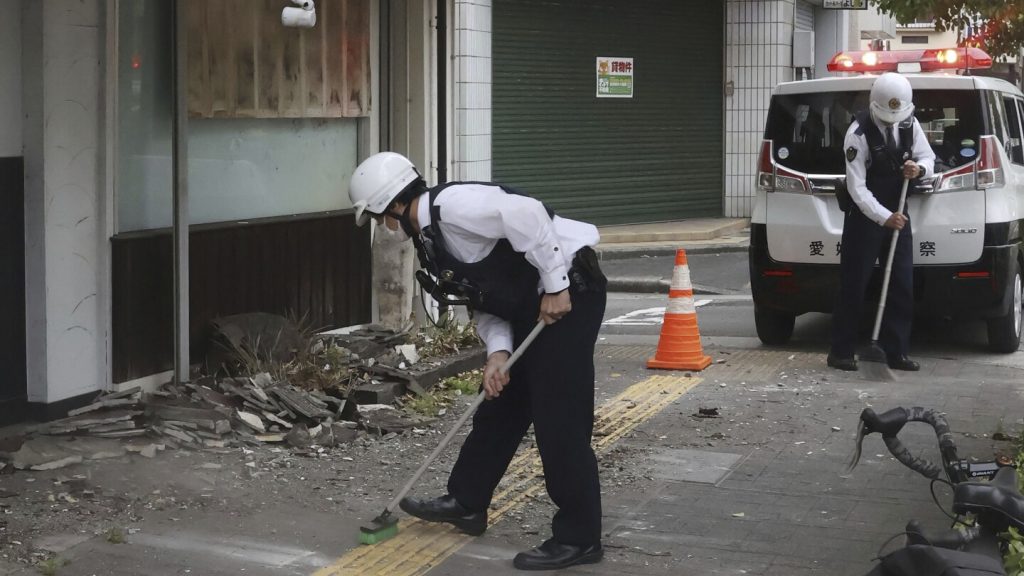The earthquake that struck southwestern Japan on Wednesday left nine people with minor injuries and caused damage such as burst water pipes and small landslides. The magnitude 6.6 temblor was centered just off the western coast of the southwestern main island of Shikoku, in an area called the Bungo Channel. Fortunately, there was no danger of a tsunami, as the quake occurred about 50 kilometers below the sea’s surface, according to the Japanese Meteorological Agency. The Fire and Disaster Management Agency reported that six people in Ehime prefecture, one in Kochi, and two in Oita suffered minor injuries, mostly from falling at home. Water pipes were ruptured in Sukumo City in Kochi prefecture, and grave stones collapsed at a Buddhist temple in Ainan town in Ehime prefecture. Falling roof tiles were also reported.
The Nuclear Regulation Authority stated that no abnormalities were reported from four reactors operating at three nuclear power plants in Shikoku and Kyushu following the earthquake. Japan is known for being one of the most earthquake-prone areas in the world, being a part of the Pacific “ring of fire.” In March 2011, a magnitude 9.0 earthquake and subsequent tsunami devastated large areas along Japan’s northeastern coast, resulting in the deaths of nearly 20,000 people and triggering the Fukushima Daiichi nuclear meltdowns. Additionally, on January 1, a magnitude 7.6 quake struck the north-central region of Noto, leaving 241 people dead.
Efforts are ongoing to assess and repair the damage caused by the recent earthquake in southwestern Japan. Fortunately, the injuries sustained were minor, and authorities are working to address issues such as burst water pipes, landslides, and other structural damages. While the earthquake did cause some disruptions and damage, there was no significant threat of a tsunami, providing some relief to residents in the affected areas. The Japanese Meteorological Agency is continuing to monitor the situation and provide updates as needed.
The importance of preparedness and response to earthquakes in Japan cannot be understated, given the country’s history of seismic activity. The government and local authorities have systems in place to mitigate the impact of earthquakes and tsunamis, as seen in the rapid response to the recent event in southwestern Japan. Lessons learned from past disasters, such as the 2011 earthquake and tsunami, have informed emergency response protocols and infrastructure improvements to enhance resilience in the face of natural disasters. The safety and well-being of residents remain a top priority for authorities as they work to address the aftermath of the earthquake and ensure that necessary support is provided to those affected.
In the wake of the earthquake in southwestern Japan, the focus is on recovery and rebuilding efforts to restore normalcy to the affected areas. With minor injuries reported and no significant damage to nuclear power plants, the immediate impact of the earthquake has been relatively contained. However, the ongoing monitoring and assessment of infrastructure and structures will be crucial in identifying any potential risks or vulnerabilities that may have been exposed by the seismic activity. Collaboration between local, regional, and national authorities will be crucial in ensuring a coordinated response to address the aftermath of the earthquake and support affected communities in their recovery efforts.
As Japan continues to navigate its vulnerability to earthquakes and other natural disasters, the resilience and preparedness of its people and institutions will remain critical in mitigating risks and minimizing the impact of such events. The significance of early warning systems, evacuation procedures, and communication channels cannot be overstated in ensuring the safety and well-being of individuals in times of crisis. The recent earthquake serves as a reminder of the ongoing threat posed by seismic activity in Japan and the importance of ongoing vigilance and readiness in the face of such events. Authorities will continue to monitor the situation and provide updates to the public as efforts to assess and address the aftermath of the earthquake progress.


